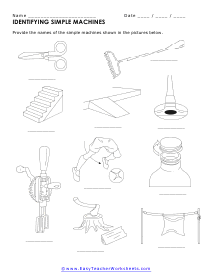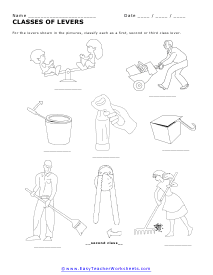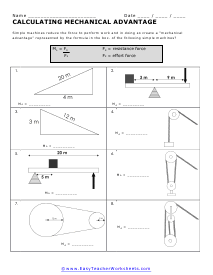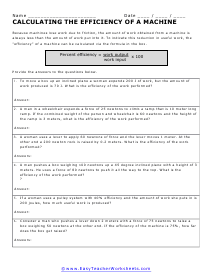The worksheet set starts by having students understand to identify various simple machines. We then advanced to identify how these tools are embedded in a more complex machine like a bicycle. We finish by having students quantify the advantage that simple machines give us. You will recognize these unsophisticated devices pretty quickly in all of the examples we will be showing you, now that you realize what they are and what they do. We will expand on with this topic by exploring compound machines and all the things that go into to making those work. We will end off the unit by learning to quantify the concept of mechanical advantage and learn about efficiencies. Engineers use these skills every day to evaluate the safest and most economical tools for their job sites. This is also how the government agencies classify the level of energy consumption in our home appliances. That is the rating on those big yellow tags when you get a new appliance.
Print Simple Machines Worksheets
Click the buttons to print each worksheet and associated answer key.

Real World Examples of Levers
The classification of levers is based on the position of the fulcrum which in turn effects the effort and force required. Provide the classification (i.e, first, second or third) for each of the levers shown below.

Using Inclined Planes
A useful kind of simple machine is an inclined plane and some of these are further classified as wedges and screws. You will be classifying screws and wedges here.

Smaller Parts in a Bike
A bicycle is collection of many smaller machines working together. Provide labels for each of the simple machines you can identify in the diagram of a bicycle below. In this example we want you to focus on finding the lever, screw, and wheel/axle located on the bike.

Compound Machines
A compound machine is what we call a machine that is a combination of two or more simple machines. See what you can find in this series of machines.

Identify That Machines
Provide the names of the type of tool that is shown in the pictures. You can break them down into simplier parts.

Classes of Levers
For the levers shown in the pictures, classify each as a first, second or third class lever.

Mechanical Advantage
Machines reduce the force needed to perform work and in doing so create a "mechanical advantage" represented by the formula in the box? This measure is quantified as mechanical advantage.

Efficiency of Machines
Because machines lose work due to friction, the amount of work obtained from a machine is always less than the amount of work put into it.
What Are Simple Machines?
The concept of simple machines was first brought to light by the Greek mathematician and philosopher, Archimedes, about 2,000 years ago. Although according to archaeologists, these machines were long used by our ancestors for at least a million years, it was Archimedes who organized the design of simple machines and the study of their functions.
Simple machines are devices used to make work easier by reducing the force needed to move objects. They allow people to perform tasks that aren’t possible with ordinary human strength and capabilities.
A simple machine is a device that has little no moving parts. Complex machines, which can do a great amount of work, are often just extended complications of the original six simple machines. You may not realize it, but you use things that are composed of these every day to make your life easier. Just think about the vehicle you used to get to school. Machines help make work easier for us, hence the word "simple". There are six of them in all. Levers are long pieces of material that form a see-saw to help us lift objects. A pulley is basically a wheel that has a rope going over it to help reduce the weight of lifting something. A ramp is an inclined plane. Inclined planes allow us to move things up vertically slower and requiring a little less force. When you smack two inclined planes together in the opposite direction you get a wedge. Wedges can be used to separate and hold things in place. Second only to fire, the wheel and axle allows us to transport things long distances. Screws are meant for holding things together they also can be used to open up areas.
The Six Simple Machines
Each kind has its own mechanism and function that helps make our work simpler by reducing the amount of force we need to exert in order to accomplish a certain job.
Inclined Plane
An inclined plane is a flat surface tilted to an angle to make it easier for an object to travel from a high position to a lower position and vice versa. It takes less force and effort to push an object up or down an inclined plane than manually lifting it. Increasing the distance traveled through gentle slopes makes the passage of heavy objects easier.
Examples of inclined planes are:
- Ramps
- Slides
- Sloping roads
- Halfpipes for skating
Wedge
A wedge is made up of two inclined planes that meet and form a sharp end in order to cut, split, or separate objects or portions of it, by applying force. They are also used to lift things or hold them in place.
Examples of wedges are:
- Knives
- Chisels
- Scissors
- Concrete nails
- Door stoppers
Screw
A screw is a cylindrical shaft surrounded by ridges called spiral threads. It converts rotational motion to linear motion. The mechanism is useful in loosening or fastening things and also in transporting objects.
One of the earliest recorded mentions of a screw is the Archimedes Screw. This was used to collect water from a lower level, allowing it to flow from one spiral to the next until it reaches the top deposit.
Examples of screws we can see every day are:
- Light bulbs
- Jar lids
- Bottle caps
- Faucets
- Bolts
Lever
A lever is a rigid bar or beam that sits on a support called a fulcrum. When an effort is applied to one end of the lever, a load is transferred to its opposite end. This will move the weight upward, making it possible for a small force to lift a heavy object.
Levers have four important parts:
- The fulcrum - the pivot or balance point
- The bar - also known as beam
- The input force - the effort
- The load - the output force
Examples of levers are balance scales, seesaws, bottle openers, wheelbarrows, and pliers.
Wheel and Axle
The wheel and axle is a round disk, known as the wheel, with a rod or beam through its center, known as the axle. The wheel rotates around an axle, rolling over the surface and reducing friction.
In the 4th millennium BC, the wheel and axle machine was recorded to be used in Sumerian chariots to help transport loads on carts that were pulled by humans or animals. It also contributed to agriculture through the use of animal traction for farming.
Other examples of wheel and axle are:
- Bikes
- Cars
- Windmills
- Analog clocks
- Doorknobs
Pulley
A pulley is one of the earliest simple machines. It consists of a wheel and groove that keeps a rope in place. In a pulley mechanism, the load is attached to one end of the rope while the force is applied to the other end. Pulleys are generally used to lift objects, especially heavy ones.
Some pulleys we can see regularly are:
- Flagpoles
- Window blinds
- Wells
- Sails on boats
- Elevators
Conclusion
Simple machines are helpful devices we use every day. These machines make our lives easier and are baselines to many new and more advanced innovations that ultimately make the world a better place.
Without simple machines, many of the things we enjoy today will cease to exist. It is important to learn about all these tools because they are the foundation of almost everything we see around us.


